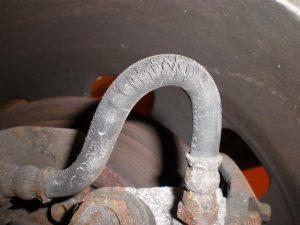Brakes: we all agree they're rather important, don't we? Hence it's of utmost importance that you can read the tell-tale signs indicating that your brakes need some attention. There are many aspects to a braking system so we'll go through the key components and help you stay safe! Do your brake pads need to be replaced? The most common braking component that needs replacement is a set of brake pads on the front wheels. All modern cars use disc brakes at the front where an hydraulically operated brake caliper pushes brake pads onto the steel disc (some high-end sports cars use carbon-ceramic discs, but steel is far more common). There's a pad on each side of the disc and they're effectively clamped together by the hydraulic force of the caliper. The system is designed for the pads to wear out quicker than the discs do as they're much cheaper to replace. Driving style and conditions have a large bearing on how long a set of pads will last so there's no defined replacement period as such. 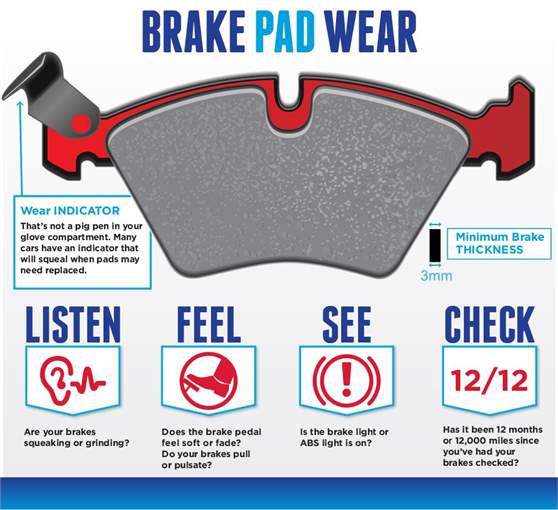 Many modern cars feature brake pads with built-in wear sensors. Some will trigger a warning light in the dashboard when the pads have worn down to a minimum level, giving the owner time to sort out replacement and some will just give an audible warning via a loud squealing noise. But not all cars have this feature so it's worth educating yourself on checking your brake pad thickness. If you're lucky, you may not even have to remove a wheel, depending on how well you can see the brake caliper, but it is easier if you do take off the wheel. As ever, jack up your car and support its weight using an axle stand before going near it. There are a couple of ways you can visually check the pad thickness. If you have alloy wheels you should be able to look through the spokes of the wheel at the caliper. Look at the thickness of the brake pad where it comes into contact with the disc as in the photo below. The section highlighted in yellow is the brake pad friction material, this should be no less than 3mm in thickness. The drawback with this method is that you can only see 1 of the 2 pads and they don't always wear at the same rate.
Many modern cars feature brake pads with built-in wear sensors. Some will trigger a warning light in the dashboard when the pads have worn down to a minimum level, giving the owner time to sort out replacement and some will just give an audible warning via a loud squealing noise. But not all cars have this feature so it's worth educating yourself on checking your brake pad thickness. If you're lucky, you may not even have to remove a wheel, depending on how well you can see the brake caliper, but it is easier if you do take off the wheel. As ever, jack up your car and support its weight using an axle stand before going near it. There are a couple of ways you can visually check the pad thickness. If you have alloy wheels you should be able to look through the spokes of the wheel at the caliper. Look at the thickness of the brake pad where it comes into contact with the disc as in the photo below. The section highlighted in yellow is the brake pad friction material, this should be no less than 3mm in thickness. The drawback with this method is that you can only see 1 of the 2 pads and they don't always wear at the same rate. 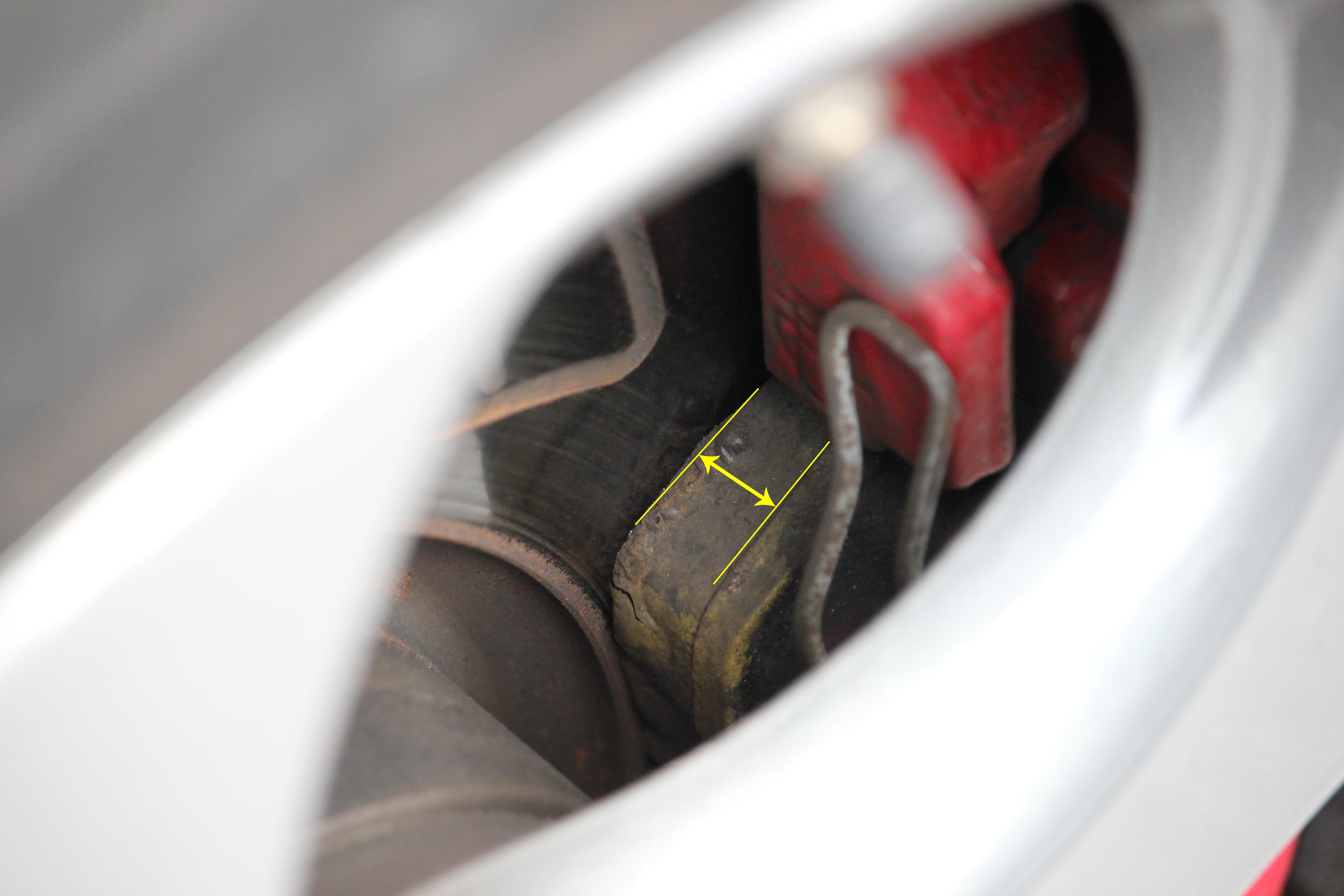 If you cant see in through the spokes of your wheel you'll have to take the wheel off to check the pad thickness. Turn the steering to full lock so that you can look directly onto the front of the caliper. There is usually an opening on the front of the caliper where you can see both pads and the disc. Be careful not to touch any part of the brakes with your hands if the car has been driven recently as they can get very hot.
If you cant see in through the spokes of your wheel you'll have to take the wheel off to check the pad thickness. Turn the steering to full lock so that you can look directly onto the front of the caliper. There is usually an opening on the front of the caliper where you can see both pads and the disc. Be careful not to touch any part of the brakes with your hands if the car has been driven recently as they can get very hot. 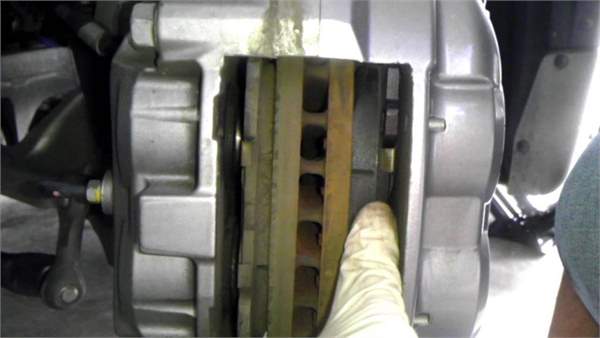 Note: it's important that you check the thickness of both the inside and the outside brake pad, as they often wear at a different rate. Likewise, check both sides of the car. Brake pad design and thickness varies from car to car, but most front pads start out with friction material of 10- to 15mm and if you've much less than 3-5mm of that left on a pad it really is time to think about changing them More and more cars also use brake discs on the rear axle, replacing drum brakes of old, but they require attention a lot less regularly, as all the weight of a car shifts forward under braking, giving the front brakes more to do. The procedure for checking the pads is the same as above, other than the fact that you can't swivel the steering. And note that rear brake pads are usually thinner to start with.
Note: it's important that you check the thickness of both the inside and the outside brake pad, as they often wear at a different rate. Likewise, check both sides of the car. Brake pad design and thickness varies from car to car, but most front pads start out with friction material of 10- to 15mm and if you've much less than 3-5mm of that left on a pad it really is time to think about changing them More and more cars also use brake discs on the rear axle, replacing drum brakes of old, but they require attention a lot less regularly, as all the weight of a car shifts forward under braking, giving the front brakes more to do. The procedure for checking the pads is the same as above, other than the fact that you can't swivel the steering. And note that rear brake pads are usually thinner to start with. 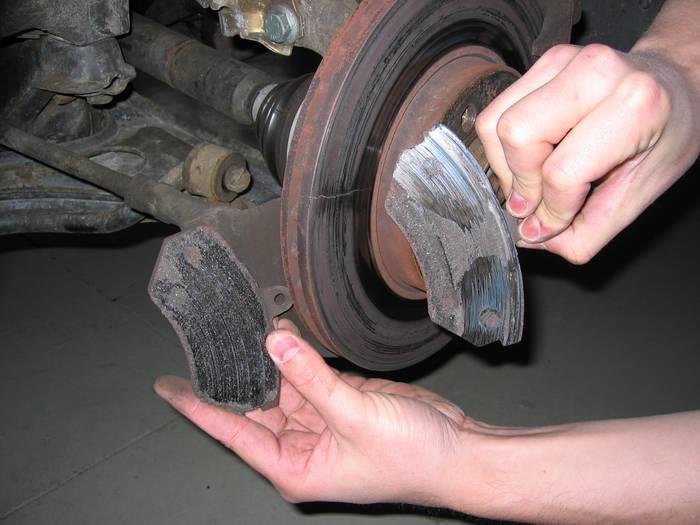 If you're getting a loud metallic screech every time you apply the brakes, or a grinding feeling through the brake pedal, it could be that the brake pads are already 'down to the metal', which means that all of the friction material has been worn away. It's crucial that you don't drive the car in this state; not only will the brakes be less effective than they should, the metal on metal contact could cause sparks and, ultimately a fire. Get the pads changed as soon as possible - and check the discs as they will probably be damaged. Do your brake discs need to be replaced? Accurately checking the wear on your brake discs is not quite as straight forward as checking the pads but you can do a basic visual inspection where most major issues should be immediately apparent. The things you're looking out for are deep scoring on the braking surface of the disc or uneven wear caused by metal on metal contact with worn pads, radial cracks often caused by overheating and excessively raised outer edges, caused by general wear.
If you're getting a loud metallic screech every time you apply the brakes, or a grinding feeling through the brake pedal, it could be that the brake pads are already 'down to the metal', which means that all of the friction material has been worn away. It's crucial that you don't drive the car in this state; not only will the brakes be less effective than they should, the metal on metal contact could cause sparks and, ultimately a fire. Get the pads changed as soon as possible - and check the discs as they will probably be damaged. Do your brake discs need to be replaced? Accurately checking the wear on your brake discs is not quite as straight forward as checking the pads but you can do a basic visual inspection where most major issues should be immediately apparent. The things you're looking out for are deep scoring on the braking surface of the disc or uneven wear caused by metal on metal contact with worn pads, radial cracks often caused by overheating and excessively raised outer edges, caused by general wear. 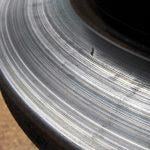
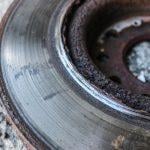
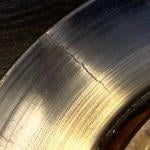
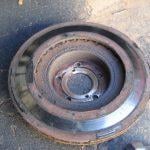 The more accurate way to check disc wear is to use a micrometre to test whether the disc thickness is within the manufacturers specified tolerances. Drum brakes If your car has rear drum brakes instead of discs, it's important to keep an eye out for leaking brake fluid,
The more accurate way to check disc wear is to use a micrometre to test whether the disc thickness is within the manufacturers specified tolerances. Drum brakes If your car has rear drum brakes instead of discs, it's important to keep an eye out for leaking brake fluid, 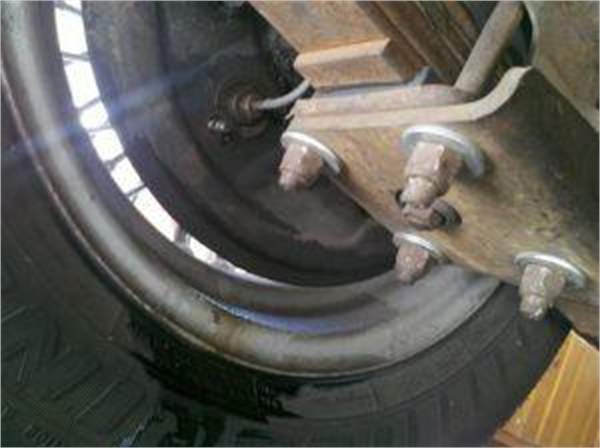 as there are hydraulically operated brake cylinders within the metal drums that push the brake shoes out and these are prone to leaking over time, potentially leading to complete brake failure. If you find a leak and you replace one of the cylinders then you really should replace the shoes too, even if the friction material is still of sufficient thickness. Checking wear on brake drums and shoes can't be done visually without removing the wheel and the drum itself. So if you're maintaining your own car it should form part of your routine checks and if a mechanic/garage is looking after your car be sure to ask them to check the drum and shoe wear (if you have them) next time your car is in for service. Parking brakes Although many modern cars use electronic parking brakes, the vast majority of cars on the road still have a manual hand brake (or foot-operated parking brake on some cars from Mercedes and Lexus in particular). Over time, the handbrake cables in these systems stretch and you'll notice the handbrake coming up higher than before to hold the car in place. This can usually be rectified by an adjustment using just a few tools, though in some cars it needs to be done from underneath, so it's a bit of a pain unless you have a ramp to hand. If no more adjustment is possible it's time to replace the handbrake cable. It's usually a set of two to three cables depending on the car and can be a fiddly job. Electronic parking brakes vary from car to car, but sometimes require interaction with the car's onboard electronics, which is best left to the experienced. Brake hoses A very common NCT/MOT failure point relates to brake hoses. They're generally made of rubber and can perish and crack over time. The NCT/MOT testers look for any sign of deterioration or damage, plus of course leaks. You can do this for yourself before the test, but changing a hose is a bit of work and you'll need to bleed the brake fluid system afterwards, so make sure you know what you are doing. Click here for an in-depth guide on brake bleeding.
as there are hydraulically operated brake cylinders within the metal drums that push the brake shoes out and these are prone to leaking over time, potentially leading to complete brake failure. If you find a leak and you replace one of the cylinders then you really should replace the shoes too, even if the friction material is still of sufficient thickness. Checking wear on brake drums and shoes can't be done visually without removing the wheel and the drum itself. So if you're maintaining your own car it should form part of your routine checks and if a mechanic/garage is looking after your car be sure to ask them to check the drum and shoe wear (if you have them) next time your car is in for service. Parking brakes Although many modern cars use electronic parking brakes, the vast majority of cars on the road still have a manual hand brake (or foot-operated parking brake on some cars from Mercedes and Lexus in particular). Over time, the handbrake cables in these systems stretch and you'll notice the handbrake coming up higher than before to hold the car in place. This can usually be rectified by an adjustment using just a few tools, though in some cars it needs to be done from underneath, so it's a bit of a pain unless you have a ramp to hand. If no more adjustment is possible it's time to replace the handbrake cable. It's usually a set of two to three cables depending on the car and can be a fiddly job. Electronic parking brakes vary from car to car, but sometimes require interaction with the car's onboard electronics, which is best left to the experienced. Brake hoses A very common NCT/MOT failure point relates to brake hoses. They're generally made of rubber and can perish and crack over time. The NCT/MOT testers look for any sign of deterioration or damage, plus of course leaks. You can do this for yourself before the test, but changing a hose is a bit of work and you'll need to bleed the brake fluid system afterwards, so make sure you know what you are doing. Click here for an in-depth guide on brake bleeding. 